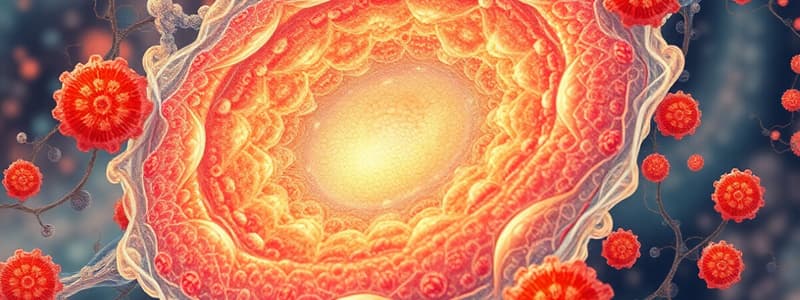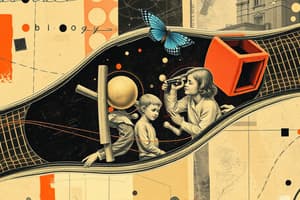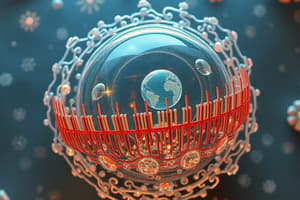Podcast
Questions and Answers
What is the primary role of the small intestine?
What is the primary role of the small intestine?
- Chemical digestion and nutrient absorption (correct)
- To store undigested food
- To produce bile
- To kill germs
Which section of the small intestine is primarily responsible for mixing food with digestive juices?
Which section of the small intestine is primarily responsible for mixing food with digestive juices?
- Ileum
- Duodenum (correct)
- Jejunum
- Cecum
What function does bile serve in the digestive system?
What function does bile serve in the digestive system?
- Digests starch
- Kills germs
- Absorbs nutrients
- Breaks down fats (correct)
Which organ stores bile until it is needed in the small intestine?
Which organ stores bile until it is needed in the small intestine?
What percentage of water is reabsorbed in the large intestine?
What percentage of water is reabsorbed in the large intestine?
What is the primary waste product released during the process of Photolysis?
What is the primary waste product released during the process of Photolysis?
Which molecules are required for the Dark Reactions/Calvin Cycle to occur?
Which molecules are required for the Dark Reactions/Calvin Cycle to occur?
In which part of the chloroplast do the Dark Reactions take place?
In which part of the chloroplast do the Dark Reactions take place?
What are the end products formed after Carbon Fixation in the Calvin Cycle?
What are the end products formed after Carbon Fixation in the Calvin Cycle?
What occurs to ATP and NADPH during the Calvin Cycle?
What occurs to ATP and NADPH during the Calvin Cycle?
During what stage does Carbon Dioxide enter the leaf for the Calvin Cycle?
During what stage does Carbon Dioxide enter the leaf for the Calvin Cycle?
What happens to the leftover hydrogen after Photolysis?
What happens to the leftover hydrogen after Photolysis?
How are NADPH and ATP utilized in the process of Dark Reactions?
How are NADPH and ATP utilized in the process of Dark Reactions?
What is the primary product of the Calvin Cycle in plants?
What is the primary product of the Calvin Cycle in plants?
Which process requires sunlight and water?
Which process requires sunlight and water?
Which of the following best describes the relationship between cellular respiration and breathing?
Which of the following best describes the relationship between cellular respiration and breathing?
In which part of the cell does cellular respiration primarily take place?
In which part of the cell does cellular respiration primarily take place?
Which set of molecules enters the dark reactions of photosynthesis?
Which set of molecules enters the dark reactions of photosynthesis?
What is formed as waste during the light reactions of photosynthesis?
What is formed as waste during the light reactions of photosynthesis?
Which of the following statements about aerobic respiration is true?
Which of the following statements about aerobic respiration is true?
What is the equation that summarizes the process of cellular respiration?
What is the equation that summarizes the process of cellular respiration?
What is the primary function of the trachea in the respiratory system?
What is the primary function of the trachea in the respiratory system?
Which of the following best describes the structure of the lungs?
Which of the following best describes the structure of the lungs?
What role does the diaphragm play in the respiratory process?
What role does the diaphragm play in the respiratory process?
What is the main function of bronchi in the respiratory system?
What is the main function of bronchi in the respiratory system?
What function do alveoli serve in the lungs?
What function do alveoli serve in the lungs?
What is the definition of gas exchange in the context of respiration?
What is the definition of gas exchange in the context of respiration?
Which of the following statements about bronchioles is true?
Which of the following statements about bronchioles is true?
What process in the digestive system precedes digestion?
What process in the digestive system precedes digestion?
What role does cholesterol play in the cell membrane?
What role does cholesterol play in the cell membrane?
Which type of transport moves molecules from a low concentration to a high concentration?
Which type of transport moves molecules from a low concentration to a high concentration?
What characteristic of the Fluid Mosaic Model allows selective passage of molecules?
What characteristic of the Fluid Mosaic Model allows selective passage of molecules?
Which of the following processes requires a membrane protein for transport?
Which of the following processes requires a membrane protein for transport?
What do simple diffusion and osmosis have in common?
What do simple diffusion and osmosis have in common?
Which molecule is primarily responsible for maintaining the shape and structure of the cell membrane?
Which molecule is primarily responsible for maintaining the shape and structure of the cell membrane?
In which type of transport do molecules move through a semipermeable membrane without the need for ATP or energy?
In which type of transport do molecules move through a semipermeable membrane without the need for ATP or energy?
What describes the movement of water molecules through a semipermeable membrane?
What describes the movement of water molecules through a semipermeable membrane?
Which type of transport uses ATP to move large molecules into the cell?
Which type of transport uses ATP to move large molecules into the cell?
What is the first process that takes place in the light-dependent reactions of photosynthesis?
What is the first process that takes place in the light-dependent reactions of photosynthesis?
What role do carrier proteins play in cellular transport?
What role do carrier proteins play in cellular transport?
Which of these is NOT a characteristic of bulk transport?
Which of these is NOT a characteristic of bulk transport?
Which structure collects sunlight during the light-dependent reactions?
Which structure collects sunlight during the light-dependent reactions?
What happens to electrons as they move through Electric Transport Chain 1?
What happens to electrons as they move through Electric Transport Chain 1?
What is phagocytosis commonly referred to as?
What is phagocytosis commonly referred to as?
Which statement is true regarding the light-independent reactions of photosynthesis?
Which statement is true regarding the light-independent reactions of photosynthesis?
Flashcards
Active Transport
Active Transport
A type of membrane transport that requires energy (ATP) to move molecules across the cell membrane against their concentration gradient (from low to high concentration).
Bulk Transport
Bulk Transport
A process that moves large molecules or particles across the cell membrane. It requires energy (ATP) and does not rely on a concentration gradient.
Endocytosis
Endocytosis
A type of bulk transport where the cell membrane engulfs and takes in large molecules or particles from the outside.
Exocytosis
Exocytosis
Signup and view all the flashcards
Photosystems
Photosystems
Signup and view all the flashcards
Electron Transport Chain (ETC)
Electron Transport Chain (ETC)
Signup and view all the flashcards
Light Dependent Reactions
Light Dependent Reactions
Signup and view all the flashcards
ATP Production in the Light Reactions
ATP Production in the Light Reactions
Signup and view all the flashcards
Photosynthesis: Carbon Fixation
Photosynthesis: Carbon Fixation
Signup and view all the flashcards
Photosynthesis: Regeneration
Photosynthesis: Regeneration
Signup and view all the flashcards
Photosynthesis: Reduction
Photosynthesis: Reduction
Signup and view all the flashcards
Photosynthesis: Light Reactions
Photosynthesis: Light Reactions
Signup and view all the flashcards
Photosynthesis: Dark Reactions
Photosynthesis: Dark Reactions
Signup and view all the flashcards
Cellular Respiration
Cellular Respiration
Signup and view all the flashcards
Aerobic Respiration
Aerobic Respiration
Signup and view all the flashcards
Breathing vs. Respiration
Breathing vs. Respiration
Signup and view all the flashcards
Trachea
Trachea
Signup and view all the flashcards
Lungs
Lungs
Signup and view all the flashcards
Diaphragm
Diaphragm
Signup and view all the flashcards
Bronchi
Bronchi
Signup and view all the flashcards
Bronchioles
Bronchioles
Signup and view all the flashcards
Alveoli
Alveoli
Signup and view all the flashcards
Gas Exchange
Gas Exchange
Signup and view all the flashcards
Mechanical Digestion
Mechanical Digestion
Signup and view all the flashcards
What is the small intestine's main job?
What is the small intestine's main job?
Signup and view all the flashcards
What are the three parts of the small intestine?
What are the three parts of the small intestine?
Signup and view all the flashcards
What does the pancreas do in digestion?
What does the pancreas do in digestion?
Signup and view all the flashcards
What is the role of bile in digestion?
What is the role of bile in digestion?
Signup and view all the flashcards
What does the large intestine do?
What does the large intestine do?
Signup and view all the flashcards
Photolysis
Photolysis
Signup and view all the flashcards
Products of Light Reactions
Products of Light Reactions
Signup and view all the flashcards
Dark Reactions (Calvin Cycle)
Dark Reactions (Calvin Cycle)
Signup and view all the flashcards
Carbon Fixation
Carbon Fixation
Signup and view all the flashcards
Reduction in Calvin Cycle
Reduction in Calvin Cycle
Signup and view all the flashcards
Regeneration in Calvin Cycle
Regeneration in Calvin Cycle
Signup and view all the flashcards
ATP to ADP conversion
ATP to ADP conversion
Signup and view all the flashcards
NADPH to NADP+ conversion
NADPH to NADP+ conversion
Signup and view all the flashcards
Cell Membrane
Cell Membrane
Signup and view all the flashcards
Fluid Mosaic Model
Fluid Mosaic Model
Signup and view all the flashcards
Phospholipids
Phospholipids
Signup and view all the flashcards
Simple Diffusion
Simple Diffusion
Signup and view all the flashcards
Osmosis
Osmosis
Signup and view all the flashcards
Facilitated Diffusion
Facilitated Diffusion
Signup and view all the flashcards
Study Notes
Cell Transport
- Important concepts include diffusion, osmosis, active transport, passive transport, and bulk transport.
- The cell membrane is a semi-permeable membrane.
- It is made up of two phospholipid layers.
- Cholesterol improves membrane stability, fluidity, and compaction.
- Phospholipids form a barrier and are the majority of the cell membrane's structure.
- Membrane proteins help transport molecules and maintain cell shape.
- Passive transport moves molecules from high to low concentration gradients and does not require energy.
- Simple diffusion involves solid and gas molecules moving across a semi-permeable membrane from high to low concentration.
- Osmosis is the movement of water molecules across a semi-permeable membrane from high to low concentration.
- Facilitated diffusion uses membrane proteins to help move molecules across a semi-permeable membrane from high to low concentration.
- Active transport moves molecules against the concentration gradient from low to high concentration and requires energy (ATP).
- Bulk transport moves large molecules across the membrane, utilizing ATP and not following concentration gradients.
- Endocytosis captures large molecules by engulfing them into the cell membrane.
- Exocytosis releases waste or large molecules out of the cell via vesicles.
Photosynthesis
- Light-dependent reactions require sunlight and occur in the thylakoid.
- Photosystems collect sunlight and convert it to chemical energy.
- There are two photosystems (Photosystem 1 and Photosystem 2) in the thylakoid.
- Light excites electrons in photosystem 2, which travel through the electron transport chain.
- During this process, ATP and NADPH are produced.
- The light-independent reactions (Calvin cycle) do not directly require sunlight, but use ATP and NADPH formed during the light-dependent reactions.
- Carbon fixation is the first step of the Calvin cycle, converting carbon dioxide to carbohydrates.
- Dark Reactions/Calvin Cycle use carbon dioxide, ATP, and NADPH to build sugars/glucose.
- Dark reactions take place in the stroma.
Cellular Respiration
- Organisms break down organic molecules to generate energy in the form of ATP (adenosine triphosphate).
- Cellular respiration mainly takes place in the mitochondria.
- Two types of respiration are Aerobic and Anaerobic respiration.
- Aerobic respiration is a process in which glucose and oxygen are used to generate ATP. This also produces carbon dioxide and water.
- Anaerobic respiration is an alternative pathway when oxygen is not available.
- Fermentation is a type of anaerobic respiration.
- Alcoholic fermentation produces ethanol and carbon dioxide.
- Lactic acid fermentation produces lactic acid.
The Human Respiratory System
- The respiratory system includes the nose/nasal cavity, mouth, pharynx, epiglottis, larynx, trachea, lungs, bronchi, bronchioles and alveoli.
- The nostrils filter, warm, and humidify incoming air.
- The mouth can serve as an alternate entry point for air if needed.
- The pharynx is a pathway for both air and food.
- The epiglottis prevents food from entering the trachea.
- The larynx contains the vocal cords.
- The trachea is the windpipe, connecting the larynx to the bronchi.
- The lungs are sponge-like organs where gas exchange occurs.
- The bronchi branch into bronchioles.
- The bronchioles lead to tiny air sacs called alveoli, where gas exchange occurs.
- The diaphragm plays a crucial role in breathing.
The Human Digestive System
- The digestive system breaks down food into smaller nutrients to be absorbed by the body.
- Functions of the digestive system include ingestion, digestion, absorption, and egestion.
- Ingestion involves the intake of food.
- Mechanical digestion involves physical processes like chewing and grinding.
- Chemical digestion involves enzymes that break down food molecules.
- Absorption involves taking digested nutrients into the bloodstream.
- Egestion involves the removal of undigested materials.
- Different types of teeth and locations in the digestive tract (mouth, pharynx, esophagus, stomach, small intestine and large intestine) have specific functions.
- Organs like the pancreas, liver, and gallbladder secrete digestive enzymes and fluids into the small intestine during digestion.
Studying That Suits You
Use AI to generate personalized quizzes and flashcards to suit your learning preferences.




